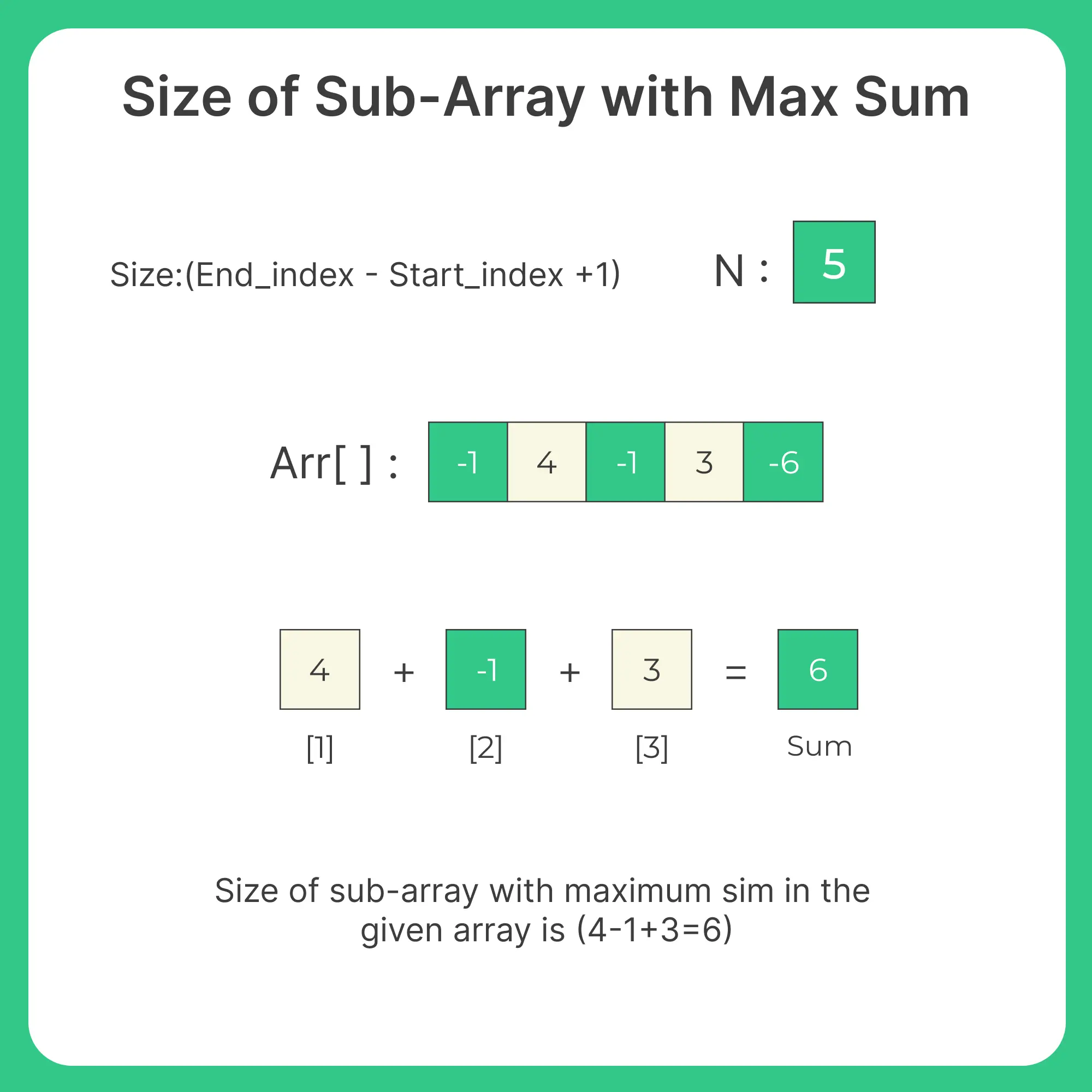0
Notifications Mark All Read
- Login
- Get Prime
Size of sub-array with Max Sum in Java
Size of sub-array with Max Sum in Java
Here, in this page we will discuss the program to find size of sub-array with max sum in Java. We use Kadane’s algorithm, which runs in O(n) time.
The idea is to keep scanning through the array and calculating the maximum sub-array that ends at every position. If current sum becomes 0 then at that point we also update the starting index.

Size of sub-array with Max Sum in Java
The “Size of Sub-array with Maximum Sum” problem is a common algorithmic problem that involves finding the length or size of a contiguous sub-array within an array of integers, such that the sum of the sub-array is maximum among all possible sub-arrays. In other words, we need to find the sub-array with the largest sum.
Here’s an example to illustrate the problem:
Given an array of integers: [-2, 1, -3, 4, -1, 2, 1, -5, 4]
The subarray with the maximum sum is [4,-1,2,1], and the sum of this sub-array is 6. Thus, the size of the subarray with the maximum sum is 4.
The problem can be solved using efficient algorithms such as Kadane’s algorithm, which has a time complexity of O(N), where N is the size of the input array. Kadane’s algorithm iterates through the array in a single pass, keeping track of the maximum sum of sub-arrays ending at each position of the array, and updating it as necessary.

Algorithm:
Initialize
max_sumto the smallest possible integer value,current_sumto 0,startto 0, andendto 0.Iterate through the array from left to right, for each element: a. Compare the current sum
current_sumplus the current element with the current element itself. If the former is greater, updatecurrent_sumto the sum, and updateendto the current index. b. If the current element is greater, start a new sub-array with the current element as the starting element, updatecurrent_sumto the current element, and update bothstartandendto the current index.Update
max_sumif the current sumcurrent_sumis greater.After the iteration, the sub-array with the maximum sum is indicated by the start and end indices, and the size of the sub-array is
end - start + 1. Return this value as the result.
Java code for Size of sub-array with max sum
import java.util.*;
public class Main {
public static void main(String[] args) {
int[] arr = {-2, 1, -3, 4, -1, 2, 1, -5, 4};
int max_size = maxSizeSubarrayWithMaxSum(arr);
System.out.println("Size of subarray with maximum sum: " + max_size);
}
public static int maxSizeSubarrayWithMaxSum(int[] nums) {
int max_sum = Integer.MIN_VALUE;
int current_sum = 0; // Initialize current_sum to 0
int start = 0; // Initialize start index to 0
int end = 0; // Initialize end index to 0
for (int i = 0; i < nums.length; i++) {
if (current_sum + nums[i] < nums[i]) {
current_sum = nums[i];
start = i;
}
else
{
current_sum += nums[i];
}
// Update max_sum if current_sum is greater
if (current_sum > max_sum)
{
max_sum = current_sum;
end = i;
}
}
// Size of subarray with max sum is end - start + 1
return end - start + 1;
}
}
Output
Size of subarray with maximum sum: 4
Prime Course Trailer
Related Banners
Get PrepInsta Prime & get Access to all 200+ courses offered by PrepInsta in One Subscription
Get over 200+ course One Subscription
Courses like AI/ML, Cloud Computing, Ethical Hacking, C, C++, Java, Python, DSA (All Languages), Competitive Coding (All Languages), TCS, Infosys, Wipro, Amazon, DBMS, SQL and others
Introduction to Trees
Binary Trees
- Binary Tree in Data Structures (Introduction)
- Tree Traversals: Inorder Postorder Preorder : C | C++ | Java
- Inorder Postorder PreOrder Traversals Examples
- Tree Traversal without Recursion
Binary Search Trees
Traversals
- Traversal in Trees
- Tree Traversals: Breadth-First Search (BFS) : C | C++ | Java
- Tree Traversals: Depth First Search (DFS) : C | C++ | Java
- Construct a Binary Tree from Postorder and Inorder
B – Trees
AVL Trees
- AVL Trees
Complete Programs for Trees
- Depth First Traversals – C | C++ | Java
- Level Order Traversal – C | C++ | Java
- Construct Tree from given Inorder and Preorder traversals – C | C++ | Java
- Construct Tree from given Postorder and Inorder traversals – C | C++ | Java
- Construct Tree from given Postorder and Preorder traversal – C | C++ | Java
- Find size of the Binary tree – C | C++ | Java
- Find the height of binary tree – C | C++ | Java
- Find maximum in binary tree – C | C++ | Java
- Check whether two tree are identical- C| C++| Java
- Spiral Order traversal of Tree- C | C++| Java
- Level Order Traversal Line by Line – C | C++| Java
- Hand shaking lemma and some Impotant Tree Properties.
- Check If binary tree if Foldable or not.- C| C++| Java
- check whether tree is Symmetric – C| C++| Java.
- Check for Children-Sum in Binary Tree- C|C++| Java
- Sum of all nodes in Binary Tree- C | C++ | Java
- Lowest Common Ancestor in Binary Tree- C | C++ | Java
Introduction to Trees
Binary Trees
- Binary Tree in Data Structures (Introduction)
- Tree Traversals: Inorder Postorder Preorder : C | C++ | Java
- Inorder Postorder PreOrder Traversals Examples
- Tree Traversal without Recursion
Binary Search Trees
Traversals
- Traversal in Trees
- Tree Traversals: Breadth-First Search (BFS) : C | C++ | Java
- Tree Traversals: Depth First Search (DFS) : C | C++ | Java
- Construct a Binary Tree from Postorder and Inorder
B – Trees
AVL Trees
- AVL Trees
Complete Programs for Trees
- Depth First Traversals – C | C++ | Java
- Level Order Traversal – C | C++ | Java
- Construct Tree from given Inorder and Preorder traversals – C | C++ | Java
- Construct Tree from given Postorder and Inorder traversals – C | C++ | Java
- Construct Tree from given Postorder and Preorder traversal – C | C++ | Java
- Find size of the Binary tree – C | C++ | Java
- Find the height of binary tree – C | C++ | Java
- Find maximum in binary tree – C | C++ | Java
- Check whether two tree are identical- C| C++| Java
- Spiral Order traversal of Tree- C | C++| Java
- Level Order Traversal LIne by Line – C | C++| Java
- Hand shaking lemma and some Impotant Tree Properties.
- Check If binary tree if Foldable or not.- C| C++| Java
- check whether tree is Symmetric C| C++| Java.
- Check for Children-Sum in Binary Tree- C|C++| Java
- Sum of all nodes in Binary Tree- C | C++ | Java
- Lowest Common Ancestor in Binary Tree. C | C++ | Java

 0
0



Login/Signup to comment